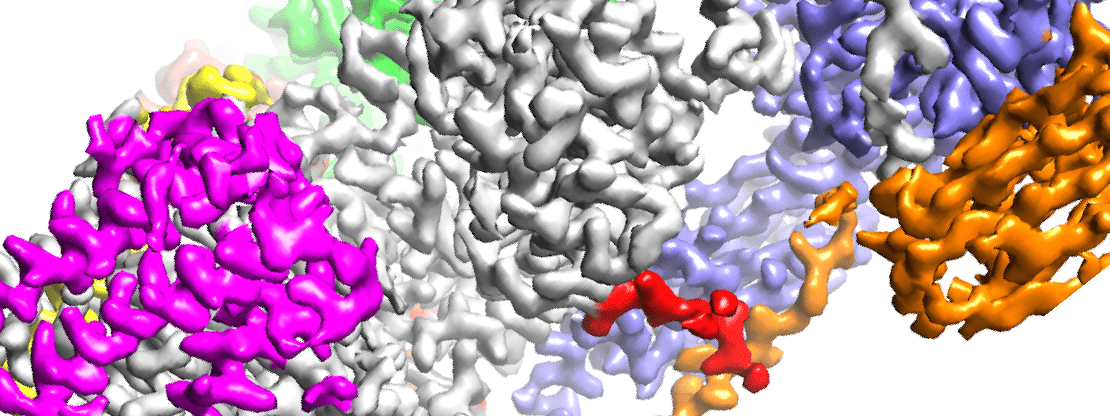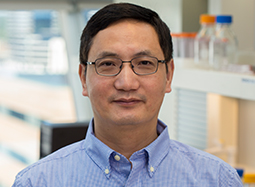Meet the scientist behind the science: Dr. Huilin Li
April 24, 2018

There is an old adage in science — structure informs function, meaning the shapes of individual molecules are closely linked to their jobs in the body. By knowing what they look like, scientists can better understand how these molecules work together to keep us healthy and how they contribute to disease when something goes awry.
As a structural biologist, Van Andel Research Institute’s Dr. Huilin Li is at the forefront of these efforts. He is an expert in a revolutionary technique called cryo-electron microscopy, or cryo-EM, which allows scientists to view molecules in their natural state at near-atomic resolution. In the past few years, Dr. Li and his colleagues have revealed the structures of the molecular machinery that copies DNA, improved our understanding of how tuberculosis-causing bacteria resist treatment, and detailed an important protein-editing process.
He also serves as director of the Institute’s David Van Andel Advanced Cryo-Electron Microscopy Suite, which is home to one of the most powerful such microscopes in the world. He joined the Institute in 2016 after many years at Stony Brook University in New York.
VAI Voice sat down with Dr. Li to discuss his work, what brought him to Grand Rapids and where he sees cryo-EM going in the future.
Where did you grow up?
I grew up in China, in the eastern part of the country. The major river there is the Yangtze River and it runs through half of the country, through Shanghai and into the Pacific. I grew up near the very end in the Yangtze River Delta, an area considered to be the fishing and agricultural center of China.
How long have you been at the Institute? What inspired you to come here?
I have been here for a year and a half. I thought Grand Rapids was a very nice setting. The immediate reason was the Institute’s state-of-the-art cryo-EM facility but, overall, it was the way the Institute is operated. We have strong institutional support, which augments and allows us to leverage outside grant funding support.
How would you describe your work in structural biology to someone without a science background?
Structural biology means studying the shapes of molecules. I think the important thing to realize that at the foundation of each cell — really, at the foundation of life — is a collection of individual molecules undergoing chemical reactions in order to complete their individual tasks. It’s very similar to our society, which is composed of individual people doing different things in a well-organized way.

At its core, biology is chemistry; it’s about molecules doing chemical work. If molecules don’t function properly, they can cause disease, so understanding their structure provides a starting point for designing new medications.
What inspired you to become a structural biologist? When did you first become interested in science?
My education was in physics, which I really enjoyed. When I was in the later stages of my Ph.D. studies, Prof. K.H. Kuo, who was my adviser and was a transformative figure in China, said he had a student a couple of years earlier who studied structural biology using cryo-EM. We also were using cryo-EM for my Ph.D. work to look at the crystal structures of solid-state inorganic and metallic compounds, and Prof. Kuo said that there was so much to do using the same method to study biological molecules. At the time, I didn’t know much about biology outside of a high school level, so I picked up book. I thought it was incredibly interesting.
Prof. Kuo is the person responsible for helping change my path. After I graduated, I applied to a postdoctoral fellowship at Lawrence Berkeley National Lab and began studying structural biology. That was in 1994, so 25 years ago.
What do you see on the horizon for structural biology? For cryo-EM?
I expect the technology will move in two major directions. With the current approach, we are able to look at isolated molecules but, right now, the molecules we’re looking at are relatively large. I think that with future improvements to technology and equipment, we’ll be able to look at average-sized proteins or other molecules. If that happens, the vast majority of molecules will be able to be visualized by cryo-EM.
Secondly, I think the most exciting part of this is not necessarily the ability to look at smaller molecules, but the ability to look at the structure of molecules in a cell without isolating them. That’s an area called cryo-electron tomography, and our microscope here at the Institute is capable of doing that.
In some special situations, tomography can be used to look at in vivo structures [ed. note: “in vivo” means in a living system], and people are starting to see structures approaching atomic resolution. The majority of studies done by cryo-EM tomography are limited to molecules that are 2–5 nanometers and result in a blobby kind of shape that is not enough to solve their structure. There are some fundamental physical limits in terms of how difficult this is to do but I think if successful, this will be the most exciting part of cryo-EM in the future.
I don’t know if all of this will happen in five years or 15 years; the horizon may be a bit longer. Visualizing molecules within a cell is a huge challenge because the cell is a very crowded environment. However, technology almost always surprises us, and I think this is the really exciting part.
What gives you hope for the future?
The research we do at the Institute is really for two purposes: one is to gain a better understanding of biology in order to understand life. The second, and a side-effect of the first, is a better appreciation for how disease occurs, which helps us devise medicines to treat disease.
By uncovering the biological mechanisms of health and illness, you really get a hopeful sense that we can help end all of these terrible diseases, like cancer and neurodegenerative diseases like Parkinson’s. Many of these conditions stem from the fact that human lifespans are much longer now, so we have to rely on medicine going forward rather than our genetics. In that sense, finding ways to treat incurable diseases may only be a matter of time.
What do you like to do outside of work?
I used to swim a lot because I grew up close to water. When I moved to Beijing to study, I would visit the indoor pool frequently.
When we moved to Grand Rapids, my wife and I were pleasantly surprised that the trail system here is so extensive. We often spend a couple hours at a time walking.
Learn more about Dr. Li and his research here. Throughout the year, we’ll be highlighting the Institute’s scientists, giving you a sneak peek at the people behind the science. Read them all here.
